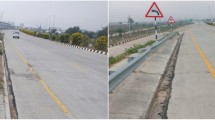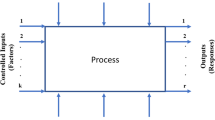Abstract
Penetration rate is one of the most critical parameters affecting the performance of TBM machines and it is complicated to predict due to uncertainty in excavating operations and geological parameters. In this paper, using Monte Carlo simulation, the penetration rate is predicted, and the sensitivity of the parameters affecting the penetration rate in the TBM machine is evaluated. For this purpose, a database containing in-situ rock properties, rock mass characteristics, and mechanical parameters related to TBM in the Queens Water transfer tunnel has been used. A mathematical model has been developed using principal component analysis to simulate. The results of evaluating the performance of the developed model showed that the model has acceptable performance (VAF = 84.4%, RMSE = 0.03, NSE = 0.82, and R2 = 0.84) and can be used in the development of Monte Carlo simulations. The simulation results showed that during the excavating route, the probability of achieving a penetration rate higher than 2.4 m/h is 90%. Also, the results of the effect of effective parameters on the penetration rate showed that with increasing parameters such as brittleness index (The most effective with a correlation coefficient of 0.528), angle between weakness plane, and tunnel axis, cutter head power, and cutter head torque, the penetration rate increases. Conversely, increasing parameters such as distance between plane of weakness, specific energy, and thrust force (The lowest effect with a correlation coefficient of − 0.13) of the machine has a negative effect on the penetration rate.














Similar content being viewed by others
Data Availability
Enquiries about data availability should be directed to the authors.
References
Acaroglu O, Ozdemir L, Asbury B (2008) A fuzzy logic model to predict specific energy requirement for TBM performance prediction. Tunn Undergr Space Technol 23:600–608
Afradi A, Ebrahimabadi A (2020) Comparison of artificial neural networks (ANN), support vector machine (SVM) and gene expression programming (GEP) approaches for predicting TBM penetration rate. SN Appl Sci 2:1–16
Aladejare AE, Akeju VO (2020) Design and sensitivity analysis of rock slope using Monte Carlo simulation. Geotech Geol Eng 38:573–585. https://doi.org/10.1007/S10706-019-01048-Z/FIGURES/9
Anele AO, Hamam Y, Abu-Mahfouz AM, Todini E (2017) Overview, comparative assessment and recommendations of forecasting models for short-term water demand prediction. Water 9:887
Barton N (1999) TBM performance in rock using QTBM. Tunnels Tunn Int 31:41–48
Bolboaca S-D, Jäntschi L (2006) Pearson versus Spearman, Kendall’s tau correlation analysis on structure-activity relationships of biologic active compounds. Leonardo J Sci 5:179–200
Bruland A (1998) Prediction model for performance and costs. Nor TBM Tunnelling, Publ, vol 11
Cai M (2011) Rock mass characterization and rock property variability considerations for tunnel and cavern design. Rock Mech Rock Eng 44:379–399
Cassinelli F (1982) Power consumption and metal wear in tunnel-boring machines: analysis of tunnel-boring operation in hard rock
Copur H, Aydin H, Bilgin N et al (2014) Predicting performance of EPB TBMs by using a stochastic model implemented into a deterministic model. Tunn Undergr Space Technol 42:1–14
Farmer IW, Glossop NH (1980) Mechanics of disc cutter penetration. Tunn Tunn (United Kingdom) 12
Ghasemi E, Shahriar K, Sharifzadeh M, Hashemolhosseini H (2010) Quantifying the uncertainty of pillar safety factor by Monte Carlo simulation—a case study. Arch Min Sci 55:623–635
Ghasemi E, Sari M, Ataei M (2012) Development of an empirical model for predicting the effects of controllable blasting parameters on flyrock distance in surface mines. Int J Rock Mech Min Sci 52:163–170
Ghasemi E, Yagiz S, Ataei M (2014) Predicting penetration rate of hard rock tunnel boring machine using fuzzy logic. Bull Eng Geol Environ 73:23–35
Gokceoglu C (2022) Assessment of rate of penetration of a tunnel boring machine in the longest railway tunnel of Turkey. SN Appl Sci 4:1–12. https://doi.org/10.1007/S42452-021-04903-Y/FIGURES/10
Gong QM, Zhao J (2007) Influence of rock brittleness on TBM penetration rate in Singapore granite. Tunn Undergr Space Technol 22:317–324
Gong Q, Zhao J (2009) Development of a rock mass characteristics model for TBM penetration rate prediction. Int J Rock Mech Min Sci 46:8–18
Gong Q, Xu H, Lu J et al (2022) Rock mass characteristics model for TBM penetration rate prediction—an updated version. Int J Rock Mech Min Sci 149:104993. https://doi.org/10.1016/J.IJRMMS.2021.104993
Graham PC (1976) Rock exploration for machine manufacturers
Hamidi JK, Shahriar K, Rezai B, Rostami J (2010) Performance prediction of hard rock TBM using Rock Mass Rating (RMR) system. Tunn Undergr Space Technol 25:333–345
Han DY, Cao P, Liu J, Zhu JB (2017) An experimental study of dependence of optimum TBM cutter spacing on pre-set penetration depth in sandstone fragmentation. Rock Mech Rock Eng 50:3209–3221
Hassanpour J, Rostami J, Khamehchiyan M et al (2010) TBM performance analysis in pyroclastic rocks: a case history of Karaj water conveyance tunnel. Rock Mech Rock Eng 43:427–445
Innaurato N, Mancini A, Rondena E, Zaninetti A (1991) Forecasting and effective TBM performances in a rapid excavation of a tunnel in Italy. In: 7th ISRM Congress. OnePetro
Jamshidi A (2018) Prediction of TBM penetration rate from brittleness indexes using multiple regression analysis. Model Earth Syst Environ 4:383–394
Kadkhodaei MH, Ghasemi E, Sari M (2022) Stochastic assessment of rockburst potential in underground spaces using Monte Carlo simulation. Environ Earth Sci 8118(81):1–15. https://doi.org/10.1007/S12665-022-10561-Z
Kherif F, Latypova A (2020) Principal component analysis. Mach Learn Methods Appl Brain Disord. https://doi.org/10.1016/B978-0-12-815739-8.00012-2
Kim K, Kim J, Ryu H et al (2020) Estimation method for TBM cutterhead drive design based on full-scale tunneling tests for application in utility tunnels. Appl Sci 10:5187
Kong D, Luo Q, Zhang W et al (2022) Reliability analysis approach for railway embankment slopes using response surface method based Monte Carlo simulation. Geotech Geol Eng 40:4529–4538. https://doi.org/10.1007/S10706-022-02168-9/METRICS
Liu RX, Kuang J, Gong Q, Hou XL (2003) Principal component regression analysis with SPSS. Comput Methods Programs Biomed 71:141–147
Mahdevari S, Shahriar K, Yagiz S, Shirazi MA (2014) A support vector regression model for predicting tunnel boring machine penetration rates. Int J Rock Mech Min Sci 72:214–229
Minaeian B, Ahangari K (2013) Estimation of uniaxial compressive strength based on P-wave and Schmidt hammer rebound using statistical method. Arab J Geosci 6:1925–1931
Minh VT, Katushin D, Antonov M, Veinthal R (2017) Regression models and fuzzy logic prediction of TBM penetration rate. Open Eng 7:60–68
Mohammadi SD, Torabi-Kaveh M, Bayati M (2015) Prediction of TBM penetration rate using intact and mass rock properties (case study: Zagros long tunnel, Iran). Arab J Geosci 8:3893–3904
Oraee K, Khorami MT, Hosseini N (2012) Prediction of the penetration rate of TBM using adaptive neuro fuzzy inference system (ANFIS). In: Proceeding of SME annual meeting and exhibit, pp 297–302
Ramezanzadeh A, Rostami J, Kastner R (2005) Influence of rock mass properties on performance of hard rock TBMs. RETC, 27–29
Rostami J (1997) Development of a force estimation model for rock fragmentation with disc cutters through theoretical modeling and physical measurement of crushed zone pressure. Colorado School of Mines Golden
Salimi A, Rostami J, Moormann C, Hassanpour J (2022) Introducing tree-based-regression models for prediction of hard rock TBM performance with consideration of rock type. Rock Mech Rock Eng 55:4869–4891. https://doi.org/10.1007/S00603-022-02868-X/TABLES/12
Saltelli A (2002) Sensitivity analysis for importance assessment. Risk Anal 22:579–590
Sanio HP (1985) Prediction of the performance of disc cutters in anisotropic rock. Int J Rock Mech Min Sci Geomech Abstr 22:153–161
Sari M, Ghasemi E, Ataei M (2014) Stochastic modeling approach for the evaluation of backbreak due to blasting operations in open pit mines. Rock Mech Rock Eng 47:771–783
Thuro K, Plinninger RJ (2003) Hard rock tunnel boring, cutting, drilling and blasting: rock parameters for excavatability. In: 10th ISRM congress. OnePetro
Wang Y, Wang J, Wang R et al (2023) TBM penetration rate prediction ensemble model based on full-scale linear cutting test. Tunn Undergr Space Technol 131:104794. https://doi.org/10.1016/J.TUST.2022.104794
Wanner H, Aeberli U (1979) Tunnelling machine performance in jointed rock. In: 4th ISRM congress. OnePetro
Yagiz S (2003) Development of rock fracture and brittleness indices to quantify the effects of rock mass features and toughness in the CSM model basic penetration for hard rock tunneling machines
Yagiz S (2008) Utilizing rock mass properties for predicting TBM performance in hard rock condition. Tunn Undergr Space Technol 23:326–339
Yagiz S (2017) New equations for predicting the field penetration index of tunnel boring machines in fractured rock mass. Arab J Geosci 10:33
Yagiz S, Karahan H (2011) Prediction of hard rock TBM penetration rate using particle swarm optimization. Int J Rock Mech Min Sci 48:427–433
Yagiz S, Karahan H (2015) Application of various optimization techniques and comparison of their performances for predicting TBM penetration rate in rock mass. Int J Rock Mech Min Sci 80:308–315
Yagiz S, Gokceoglu C, Sezer E, Iplikci S (2009) Application of two non-linear prediction tools to the estimation of tunnel boring machine performance. Eng Appl Artif Intell 22:808–814. https://doi.org/10.1016/J.ENGAPPAI.2009.03.007
Yoo W, Mayberry R, Bae S et al (2014) A study of effects of multicollinearity in the multivariable analysis. Int J Appl Sci Technol 4:9
Zhao J, Gong QM (2006) Rock mechanics and excavation by tunnel boring machine–issues and challenges. In: Rock mechanics in underground construction: (with CD-ROM). World Scientific, pp 83–96
Funding
Not applicable.
Author information
Authors and Affiliations
Corresponding author
Ethics declarations
Conflict of interest
The authors declare that they have no conflict of interest.
Additional information
Publisher's Note
Springer Nature remains neutral with regard to jurisdictional claims in published maps and institutional affiliations.
Rights and permissions
Springer Nature or its licensor (e.g. a society or other partner) holds exclusive rights to this article under a publishing agreement with the author(s) or other rightsholder(s); author self-archiving of the accepted manuscript version of this article is solely governed by the terms of such publishing agreement and applicable law.
About this article
Cite this article
Jafarshirzad, P., Ghasemi, E., Yagiz, S. et al. Evaluation of Hard Rock Tunnel Boring Machine (TBM) Performance Using Stochastic Modeling. Geotech Geol Eng 41, 3513–3529 (2023). https://doi.org/10.1007/s10706-023-02471-z
Received:
Accepted:
Published:
Issue Date:
DOI: https://doi.org/10.1007/s10706-023-02471-z




